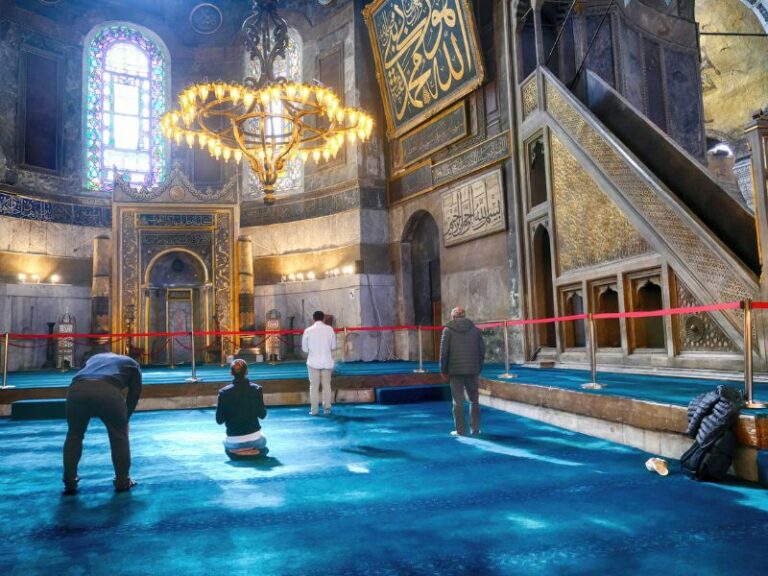Table of Contents
Introduction
Hagia Sophia stands as one of the most extraordinary architectural achievements in human history. Built in 537 AD under Emperor Justinian I, it represents a turning point in the evolution of sacred architecture of Hagia Sophia, merging the engineering brilliance of the Classical world with the spiritual symbolism of Byzantine aesthetics.
The result is a structure that is both monumental and ethereal, a fusion of Roman technical mastery and Byzantine artistic vision. While the Romans perfected the art of massive domes, arches, and structured symmetry, the Byzantines introduced ornate interiors, mystical lighting effects, and spiritual symbolism.
Together, these elements created a revolutionary new type of sacred space, one that would influence religious architecture of Hagia Sophia for centuries. In this article, we will explore how Hagia Sophia successfully blends Classical Roman and Byzantine architectural styles, making it one of the most iconic structures in history.
Classical Roman Influence on the architecture of Hagia Sophia

Hagia Sophia’s origins are deeply rooted in Roman architectural traditions, drawing inspiration from imperial basilicas, grand public forums, and monumental engineering techniques. At its core, the structure retains the rectangular floor plan of a Roman basilica, but with dramatic modifications that set it apart from its predecessors.
The Legacy of Roman Engineering
Roman architecture was known for its bold engineering solutions, solid materials, and grandiose scale.
From the Pantheon’s massive dome to the vaulted arches of the Colosseum, the Romans had mastered the art of creating large, open spaces that could stand for centuries. Hagia Sophia inherited many of these innovations, particularly in its use of arches, vaults, and domes.
The architecture of Hagia Sophia also reflects influences from Roman bathhouses and public halls, which featured expansive interiors with high ceilings and a rhythmic sequence of columns and arches. The presence of colonnaded galleries, a large central nave, and an elevated clerestory further ties Hagia Sophia to the Classical tradition.
The Dome: A Roman-Inspired Marvel
The most striking Classical influence on Hagia Sophia is its colossal central dome, which was unprecedented for its time.
Roman architects had long experimented with domes, with the Pantheon in Rome being one of the most famous examples. However, while the Pantheon’s dome was supported by a circular drum, the architects of Hagia Sophia developed a groundbreaking system using pendentives, allowing them to place a circular dome over a square space.
This innovation built upon Roman vaulting techniques, yet created something entirely new—a sense of lightness and spiritual ascent.
Instead of appearing heavy and grounded, as in most Classical Roman structures, Hagia Sophia’s dome seems to float effortlessly above the worshippers, an effect that would become a defining feature of Byzantine religious architecture of Hagia Sophia.
The Byzantine Architectural Evolution

While the structure owes much to Roman engineering principles, its execution reflects the distinct aesthetic and spiritual vision of Byzantine architecture. Hagia Sophia was not simply an improved version of a Roman basilica; it was a new kind of space designed to evoke the divine.
The Shift from Classical to Byzantine Aesthetics
Unlike Classical Roman buildings, which emphasized geometric symmetry and rigid proportions, Byzantine architecture of Hagia Sophia introduced a more fluid, dynamic sense of space. Hagia Sophia’s massive dome resting on delicate pendentives creates an effect that is less about imposing grandeur and more about sacred transcendence.
The focus shifts from human dominance over space to a celestial vision of heaven on earth. The Byzantines also moved away from external ornamentation, which was common in Roman temples, and instead placed a greater emphasis on interior decoration.
The richness of Hagia Sophia’s golden mosaics, intricate marble inlays, and shimmering light effects make the interior an awe-inspiring, otherworldly experience.
Pendentives: The Byzantine Breakthrough
The introduction of pendentives in Hagia Sophia was a groundbreaking development. While Roman domes typically sat on circular or octagonal bases, Byzantine architects sought a way to seamlessly transition from a square floor plan to a circular dome.
Pendentives, which are curved triangular sections, allowed the massive dome to rest on four colossal piers, effectively distributing its weight without the need for thick supporting walls.
This allowed for an open, uninterrupted interior, unlike the segmented spaces of Roman basilicas. The result was a dome that appears suspended in the heavens, reinforcing the Byzantine emphasis on spiritual elevation.
Interior Ornamentation: The Byzantine Touch
Roman temples and basilicas were often adorned with statues and relief sculptures, reflecting the Classical love for realistic human forms. Byzantine churches, however, replaced these with abstract mosaics, religious iconography, and symbolic patterns.
Hagia Sophia’s interior was once covered in golden mosaics depicting Christ, the Virgin Mary, and celestial figures, creating an ethereal atmosphere where light played a central role in the divine experience. The use of polished marble, gilded surfaces, and deep colors created an immersive spiritual environment, one that felt more like a mystical vision than a man-made structure.
The Harmonious Fusion of Classical and Byzantine Styles

Hagia Sophia does not simply alternate between Classical and Byzantine elements; instead, it seamlessly blends them into a cohesive whole. This is evident in several ways:
A Basilica Transformed
The Classical basilica, with its long rectangular form, was transformed into a domed space that defied traditional proportions. The transition from horizontal movement to vertical ascension is what makes Hagia Sophia so unique—while rooted in Roman spatial planning, it ultimately achieves a Byzantine vision of cosmic grandeur.
The Evolution of Materials and Techniques
The Romans were known for their use of heavy concrete and stone, while the Byzantines sought to make their structures lighter and more ethereal. Hagia Sophia’s architects used lightweight bricks from Rhodes, allowing the dome to be larger and taller without straining the foundation.
The structure also employs lead-infused joints, allowing it to flex during earthquakes rather than crack under pressure. This blending of Roman engineering with Byzantine innovation ensured that Hagia Sophia would not only stand but endure for over a millennium.
The Influence of Hagia Sophia on Later Architecture
Hagia Sophia’s hybrid design had a profound impact on both Eastern and Western architecture. It inspired the construction of later Byzantine churches, such as St. Mark’s Basilica in Venice, and played a crucial role in shaping Ottoman mosque architecture.
The Süleymaniye Mosque and the Blue Mosque in Istanbul both borrow heavily from its domed structure and cascading semi-domes, proving the lasting influence of this architectural synthesis.
Conclusion
Hagia Sophia is not just a Byzantine church or a Roman-inspired basilica—it is a fusion of two architectural worlds, a structure where Classical engineering meets Byzantine spirituality.
Its Roman foundations, soaring dome, and ethereal interior decoration showcase the best of both traditions, making it one of the most influential buildings in human history. As one stands beneath its vast dome, surrounded by shimmering mosaics and monumental columns, it becomes clear why architecture of Hagia Sophia remains an unparalleled masterpiece.






